traction control TOYOTA MIRAI 2019 Owners Manual (in English)
[x] Cancel search | Manufacturer: TOYOTA, Model Year: 2019, Model line: MIRAI, Model: TOYOTA MIRAI 2019Pages: 528, PDF Size: 11.84 MB
Page 10 of 528

10
MIRAI_OM_USA_OM62054U(18MY)_O
M62048U(19MY)The SRS airbag and seat belt pretensioner devices in your Toyot
a contain
explosive chemicals. If the vehicle is scrapped with the airbag s and seat belt
pretensioners left as they are, this may cause an accident such as fire. Be
sure to have the systems of the SRS airbag and seat belt preten sioner
removed and disposed of by a qualified service shop or by your Toyota dealer
before you scrap your vehicle.
Special handling may apply, See www.dtsc.ca.gov/hazardouswaste/ perchlorate.
Your vehicle has components that may contain perchlorate. These compo-
nents may include airbag, seat belt pretensioners, and wireless remote con-
trol batteries.
Scrapping of your Toyota
Perchlorate Material
WARNING
■ General precautions while driving
Driving under the influence: Never drive your vehicle when unde r the influ-
ence of alcohol or drugs that have impaired your ability to operate your vehi-
cle. Alcohol and certain drugs delay reaction time, impair judg ment and
reduce coordination, which could lead to an accident that could result in
death or serious injury.
Defensive driving: Always drive defensively. Anticipate mistake s that other
drivers or pedestrians might make and be ready to avoid acciden ts.
Driver distraction: Always give your full attention to driving. Anything that
distracts the driver, such as adjusting controls, talking on a cellular phone or
reading can result in a collision with resulting death or serio us injury to you,
your occupants or others.
■ General precaution regar ding children’s safety
Never leave children unattended in the vehicle, and never allow children to
have or use the key.
Children may be able to start the vehicle or shift the vehicle into neutral.
There is also a danger that children may injure themselves by p laying with
the windows, the moon roof, or other features of the vehicle. In addition,
heat build-up or extremely cold temperatures inside the vehicle can be fatal
to children.
Page 88 of 528
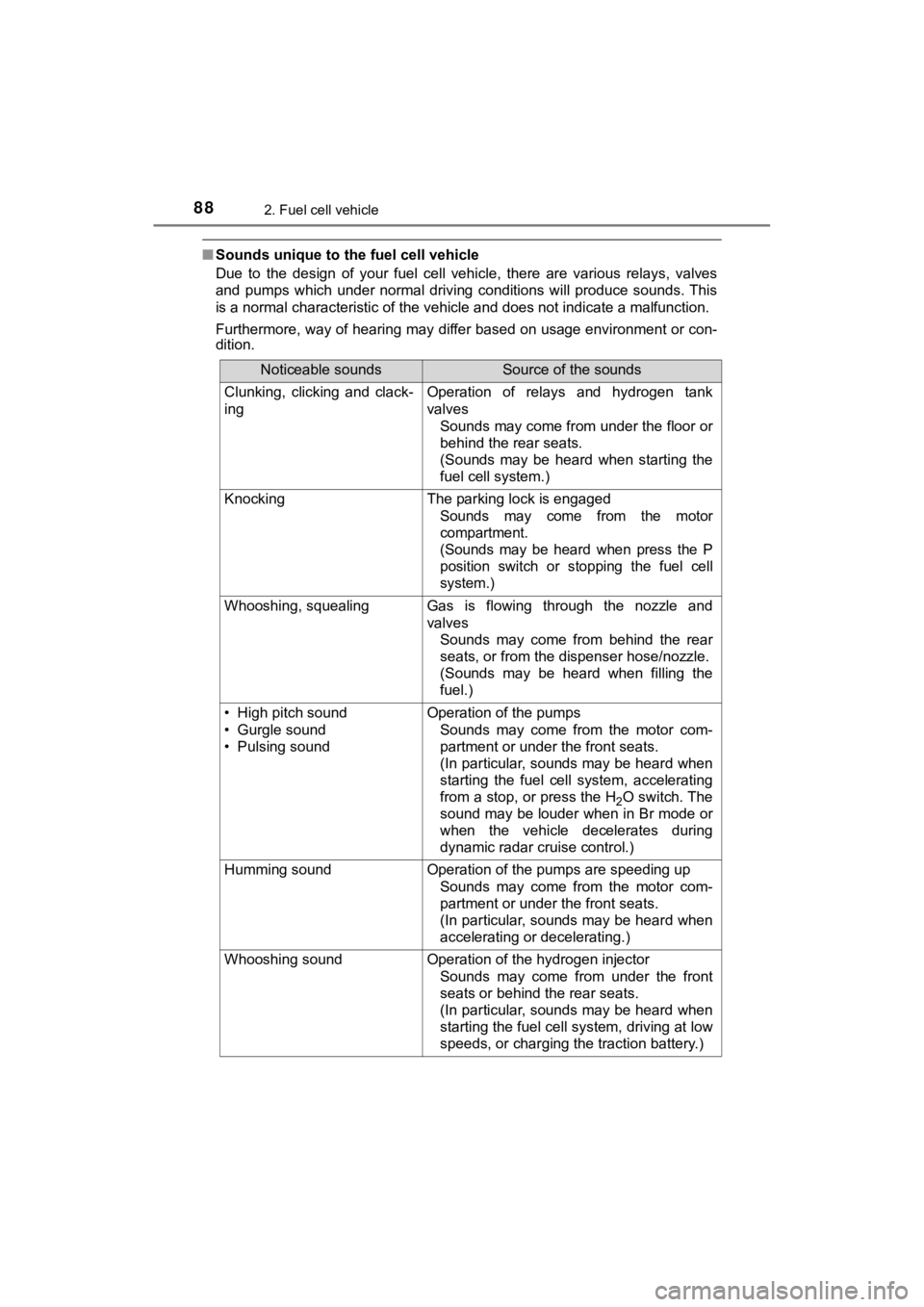
882. Fuel cell vehicle
MIRAI_OM_USA_OM62054U(18MY)_O
M62048U(19MY)
■Sounds unique to the fuel cell vehicle
Due to the design of your fuel cell vehicle, there are various relays, valves
and pumps which under normal driving conditions will produce so unds. This
is a normal characteristic of the vehicle and does not indicate a malfunction.
Furthermore, way of hearing may differ based on usage environme nt or con-
dition.
Noticeable soundsSource of the sounds
Clunking, clicking and clack-
ingOperation of relays and hydrogen tank
valves
Sounds may come from under the floor or
behind the rear seats.
(Sounds may be heard when starting the
fuel cell system.)
KnockingThe parking lock is engaged
Sounds may come from the motor
compartment.
(Sounds may be heard when press the P
position switch or stopping the fuel cell
system.)
Whooshing, squealingGas is flowing through the nozzle and
valvesSounds may come from behind the rear
seats, or from the dispenser hose/nozzle.
(Sounds may be heard when filling the
fuel.)
• High pitch sound
• Gurgle sound
• Pulsing soundOperation of the pumpsSounds may come from the motor com-
partment or under the front seats.
(In particular, sounds may be heard when
starting the fuel cell system, accelerating
from a stop, or press the H
2O switch. The
sound may be louder when in Br mode or
when the vehicle decelerates during
dynamic radar cruise control.)
Humming soundOperation of the pumps are speeding up
Sounds may come from the motor com-
partment or under the front seats.
(In particular, sounds may be heard when
accelerating or decelerating.)
Whooshing sound Operation of the hydrogen injectorSounds may come from under the front
seats or behind the rear seats.
(In particular, sounds may be heard when
starting the fuel cell system, driving at low
speeds, or charging the traction battery.)
Page 91 of 528
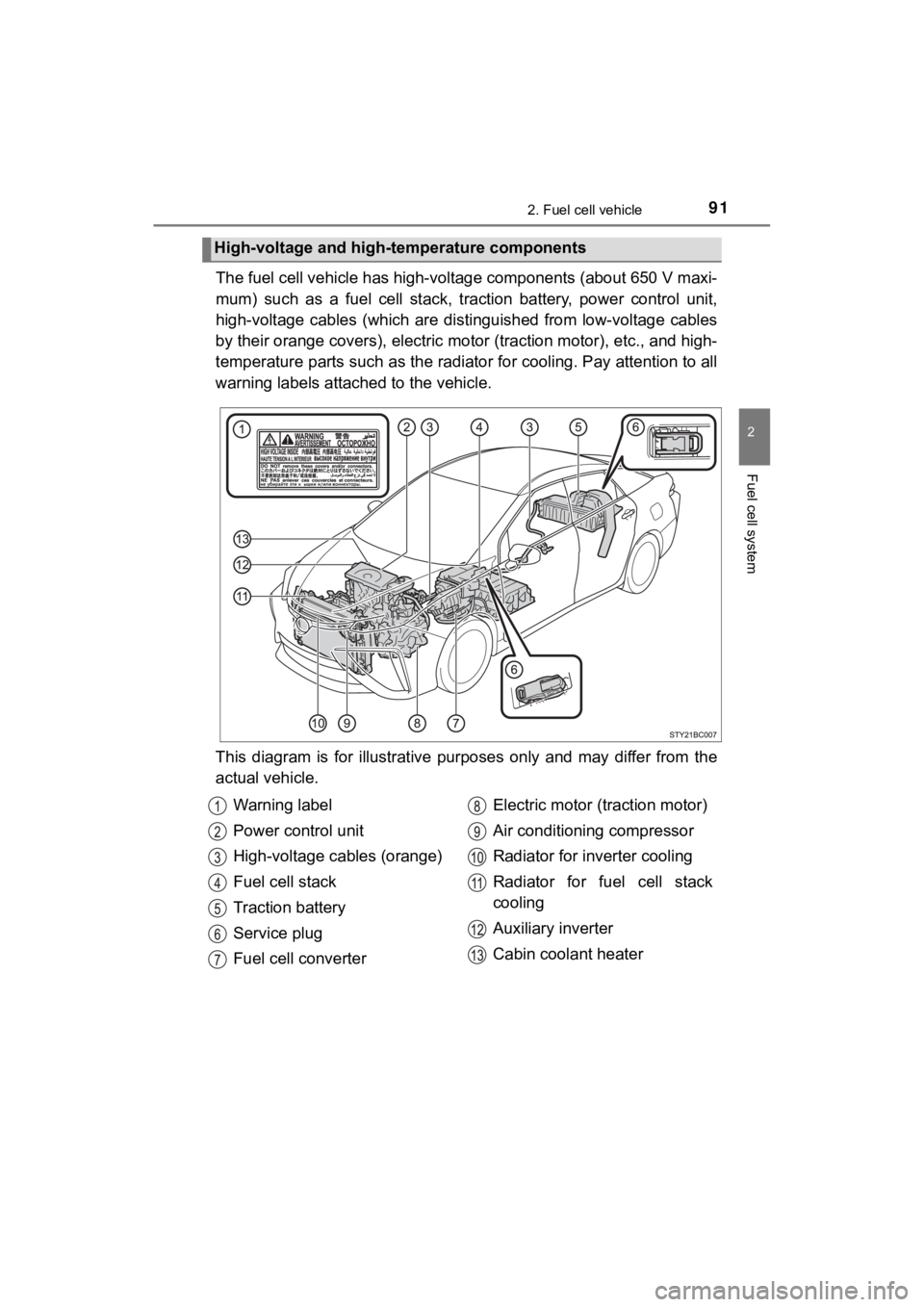
912. Fuel cell vehicle
2
Fuel cell system
MIRAI_OM_USA_OM62054U(18MY)_O
M62048U(19MY)
The fuel cell vehicle has high-voltage components (about 650 V m axi-
mum) such as a fuel cell stack, traction battery, power control unit,
high-voltage cables (which are di stinguished from low-voltage cables
by their orange covers), electric motor (traction motor), etc., and high-
temperature parts such as the radiator for cooling. Pay attenti on to all
warning labels attached to the vehicle.
This diagram is for illustrative purposes only and may differ f rom the
actual vehicle.
High-voltage and high-temperature components
Warning label
Power control unit
High-voltage cables (orange)
Fuel cell stack
Traction battery
Service plug
Fuel cell converter Electric motor (traction motor)
Air conditioning compressor
Radiator for inverter cooling
Radiator for fuel cell stack
cooling
Auxiliary inverter
Cabin coolant heater
Page 118 of 528
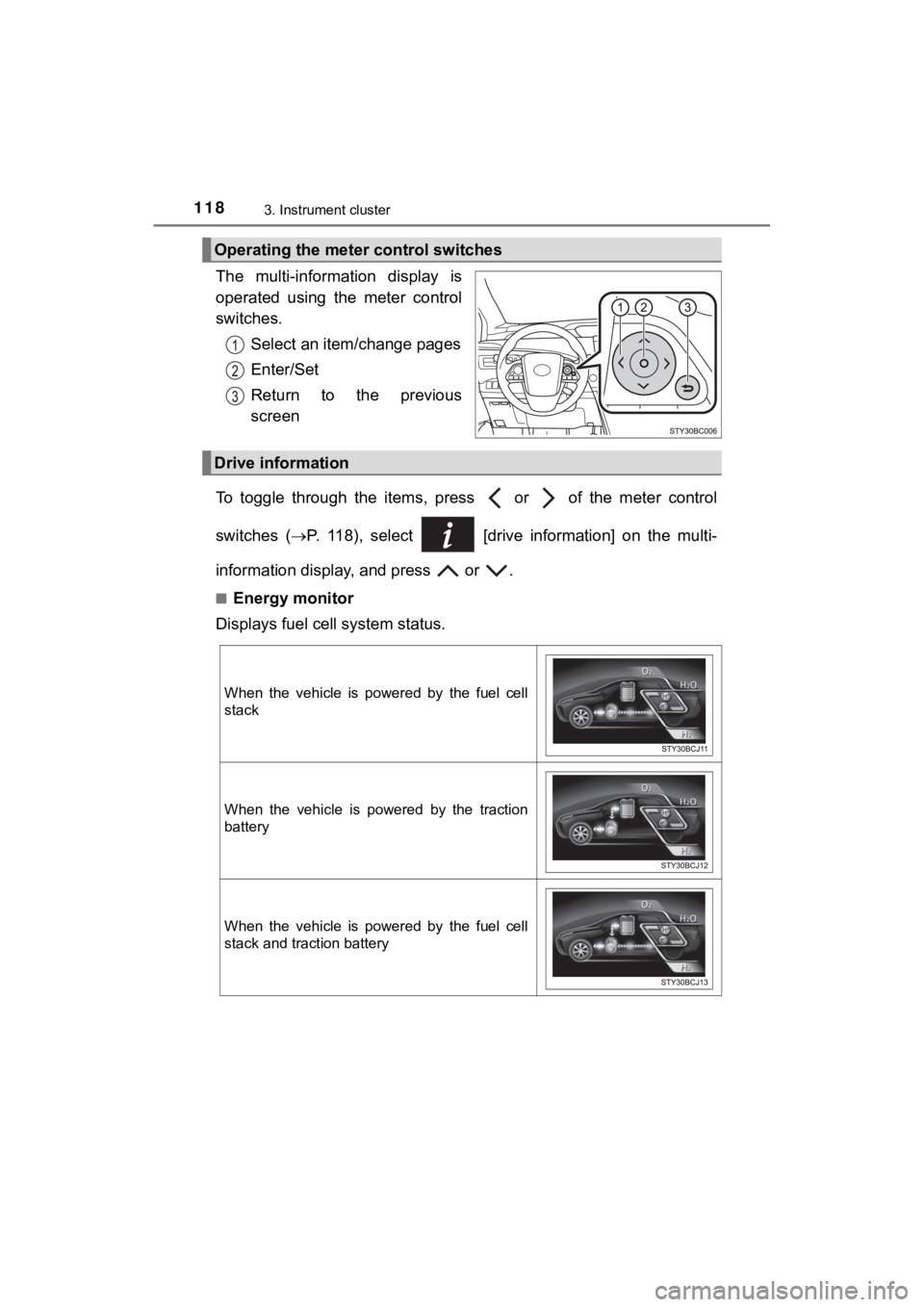
1183. Instrument cluster
MIRAI_OM_USA_OM62054U(18MY)_O
M62048U(19MY)
The multi-information display is
operated using the meter control
switches.Select an item/change pages
Enter/Set
Return to the previous
screen
To toggle through the items, press or of the meter control
switches ( P. 118), select [drive information] on the multi-
information display, and press or .
■Energy monitor
Displays fuel cell system status.
Operating the meter control switches
Drive information
When the vehicle is powered by the fuel cell
stack
When the vehicle is powered by the traction
battery
When the vehicle is powered by the fuel cell
stack and traction battery
Page 196 of 528

1965-2. Driving procedures
MIRAI_OM_USA_OM62054U(18MY)_O
M62048U(19MY)
■For the shift positions
●When the power switch is off, the shift position cannot be chan ged.
● When the power switch is in ON mode (the fuel cell system is not operating),
the shift position can only be changed to N. The shift position will be
changed to N even if the shift position is shifted to D or R and held in that
position.
● When the “READY” indicator is on, the shift position can be cha nged from P
to D, N or R.
● When the “READY” indicator is flashing, the shift position cann ot be
changed from P to another position even if the shift lever is o perated.
Wait until the “READY” indicator changes from a flashing to a s olid light, and
then operate the shift lever again.
In addition, if an attempt is made to change the shift position by moving the
shift lever or by pressing the P position switch in any of the following situa-
tions, a buzzer will sound and the shifting operation will be disabled or the
shift position will automatically change to N. When this happen s, select an
appropriate shift position.
● When attempting to change the shift position from P without dep ressing the
brake pedal, the shift position change is invalidated.
● Situations where the shift position will automatically change t o N:
• When the P position switch is pressed while the vehicle is running.
*1
• When an attempt is made to select the R position by moving the shift
lever when the vehicle is moving forward.
*2
• When an attempt is made to select the D position by moving the shift
lever when the vehicle is moving in reverse.
*3
• When an attempt is made to change the shift position from R to Br mode
by moving the shift lever.
*1: Shift position may be changed to P when driving at extremely l ow speeds.
*2: Shift position may be changed to R when driving at low speeds.
*3: Shift position may be changed to D when driving at low speeds.
■ Br mode
Depending on the condition of the traction battery, Br mode may not be avail-
able.
In that case, a message is displayed on the multi-information d isplay.
■ Sounds when in Br mode
P. 88
■ Restraining sudden start (Drive-Start Control)
P. 173
■ Reverse warning buzzer
When shifting into R, a buzzer will sound to inform the driver that the shift
position is in R.
Page 295 of 528
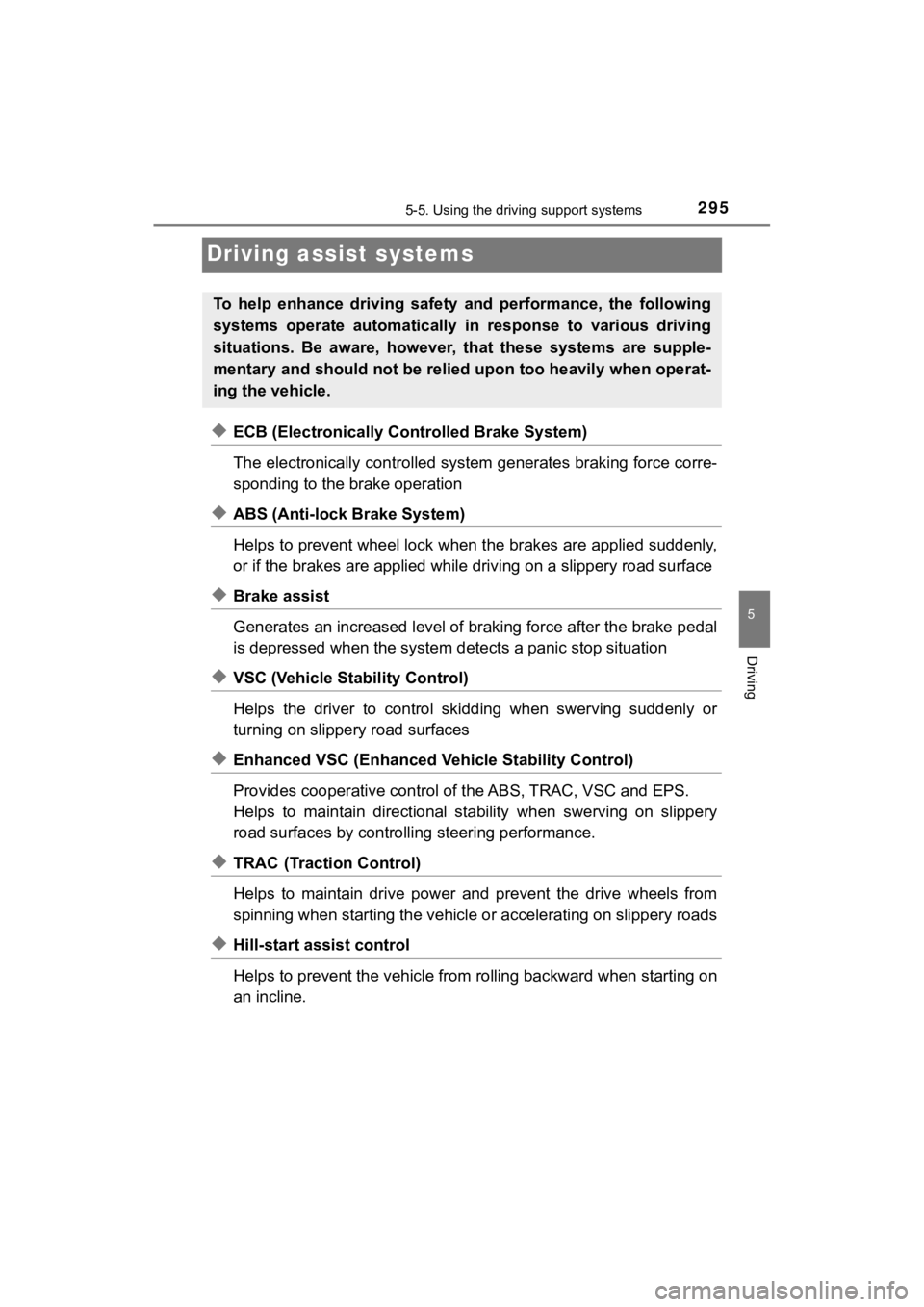
2955-5. Using the driving support systems
5
Driving
MIRAI_OM_USA_OM62054U(18MY)_O
M62048U(19MY)
Driving assist systems
◆ECB (Electronically Controlled Brake System)
The electronically controlled system generates braking force corre-
sponding to the brake operation
◆ABS (Anti-lock Brake System)
Helps to prevent wheel lock when the brakes are applied suddenl y,
or if the brakes are applied while driving on a slippery road surface
◆Brake assist
Generates an increased level of braking force after the brake p edal
is depressed when the system de tects a panic stop situation
◆VSC (Vehicle Stability Control)
Helps the driver to control skidding when swerving suddenly or
turning on slippery road surfaces
◆Enhanced VSC (Enhanced Vehicle Stability Control)
Provides cooperative control of the ABS, TRAC, VSC and EPS.
Helps to maintain directional stability when swerving on slippe ry
road surfaces by controlling steering performance.
◆TRAC (Traction Control)
Helps to maintain drive power and prevent the drive wheels from
spinning when starting the vehicl e or accelerating on slippery roads
◆Hill-start assist control
Helps to prevent the vehicle from rolling backward when startin g on
an incline.
To help enhance driving safety and performance, the following
systems operate autom atically in response to various driving
situations. Be aware, however, that these systems are supple-
mentary and should not be relied upon too heavily when operat-
ing the vehicle.
Page 476 of 528
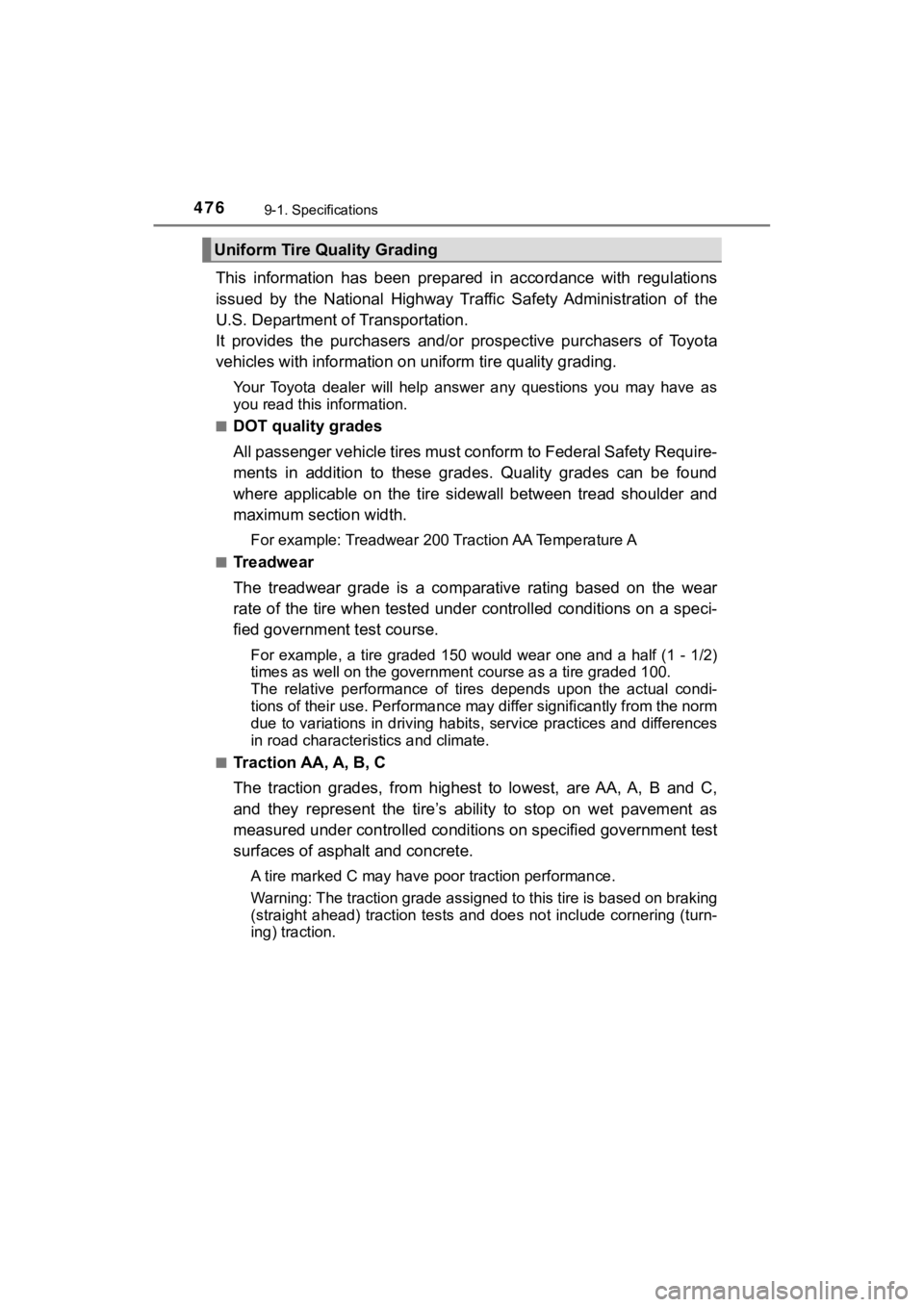
4769-1. Specifications
MIRAI_OM_USA_OM62054U(18MY)_O
M62048U(19MY)
This information has been prepared in accordance with regulations
issued by the National Highway Tr affic Safety Administration of the
U.S. Department of Transportation.
It provides the purchasers and/or prospective purchasers of Toyota
vehicles with info rmation on uniform ti re quality grading.
Your Toyota dealer will help answer any questions you may have as
you read this information.
■DOT quality grades
All passenger vehicle tires must conform to Federal Safety Requ ire-
ments in addition to these grades. Quality grades can be found
where applicable on the tire sidewall between tread shoulder an d
maximum section width.
For example: Treadwear 200 Traction AA Temperature A
■Treadwear
The treadwear grade is a comparative rating based on the wear
rate of the tire when tested under controlled conditions on a s peci-
fied government t est course.
For example, a tire graded 150 would wear one and a half (1 - 1 /2)
times as well on the governmen t course as a tire graded 100.
The relative performance of tires depends upon the actual condi -
tions of their use. Performance ma y differ significantly from the norm
due to variations in driving habits, service practices and diff erences
in road characteristics and climate.
■Traction AA, A, B, C
The traction grades, from highest to lowest, are AA, A, B and C ,
and they represent the tire’s ability to stop on wet pavement a s
measured under controlled conditions on specified government te st
surfaces of asphalt and concrete.
A tire marked C may have p oor traction performance.
Warning: The traction grade assigned to this tire is based on b raking
(straight ahead) traction tests and does not include cornering (turn-
ing) traction.
Uniform Tire Quality Grading
Page 514 of 528

514Alphabetical index
MIRAI_OM_USA_OM62054U(18MY)_O
M62048U(19MY)
Back-up lightsReplacing light bulb .............. 405
Battery (12-volt battery) .......... 374 Battery checking ................... 374
If the 12-volt battery is discharged .......................... 452
Preparing and checking before winter....................... 301
Warning message ................. 426
Battery (traction battery)..... 86, 91 Air intake vent ......................... 93
Charging ................................. 89
Location ............................ 86, 91
Warning message ................. 426
Blind Spot Monitor (BSM) ....... 300 Blind Spot Monitor function ... 289
Rear Crossing Traffic Alert function ............................... 292
Bluetooth
®*
Audio system*
Hands-free system (for cellular phone)
*
Navigation system*
Bottle holders .......................... 324
Brake Fluid ...................................... 470
Parking brake........................ 200
Regenerative braking.............. 89
Warning light ......................... 418
Brake assist ............................. 295
Break-in tips ............................ 174
Brightness control Instrument panel light
control................................. 113
BSM (Blind Spot Monitor) ....... 300 Blind Spot Monitor function ... 289
Rear Cross Traffic Alert
function ............................... 292 Care .................................. 352, 356
Aluminum wheels ................. 353
Exterior ................................. 352
Interior .................................. 356
Seat belts.............................. 357
Cargo capacity......................... 183
CD player
*
Chains ...................................... 302
Child restraint system............... 56 Booster seats installation........ 64
Convertible seats installation ............................ 63
Front passenger occupant classification syst em ............ 49
Infant seats definition.............. 58
Infant seats installation ........... 62
Installing a CRS to the passenger seat..................... 59
Installing CRS with LATCH anchors ................................ 67
Installing CRS with seat belts...................................... 62
Installing CRS with top tether
strap ..................................... 69
Child safety ................................ 55 12-volt battery precautions................. 376, 456
Airbag precautions.................. 39
Child restraint system ............. 56
How your child should wear the seat belt.......................... 32
Power window lock switch .... 167
Power window precautions ... 169
Rear door child-protectors .... 135
Removed electronic key battery precautions............. 401
Seat belt extender precautions........................... 35
Seat belt precautions .............. 34
Seat heater precautions ....... 315
Trunk precautions ................. 141
BC
Page 516 of 528

516Alphabetical index
MIRAI_OM_USA_OM62054U(18MY)_O
M62048U(19MY)
DoorsAutomatic door locking
and unlocking systems ....... 135
Door glasses ......................... 167
Door lock............................... 134
Door windows ....................... 167
Open door warning buzzer ... 136
Open door warning light........ 420
Outside rear view mirrors...... 164
Rear door child-protector ...... 135
Drive information ..................... 118
Driver’s seat belt reminder
light......................................... 421
Driver’s seat position
memory .................................. 153
Driving Break-in tips .......................... 174
Correct driving posture ........... 28
Driving advice ....................... 102
Fuel cell vehicle driving
tips ...................................... 102
Procedures ........................... 172
Winter drive tips .................... 301
Driving position memory ........ 153 Memory recall function.......... 155
Dynamic radar cruise control .................................... 253 ECB (Electronically Controlled
Brake System) ...................... 295
Eco drive mode........................ 195
EDR (Event data recorder).......... 9
Electric motor (traction motor) Location ............................ 86, 91
Specification ......................... 468
Electric Power Steering
(EPS) ...................................... 296 Function ................................ 296
Warning light......................... 419
Electronic key Battery-saving function ......... 145
If the electronic key does not operate properly ................. 449
Replacing the battery............ 400
Electronically Controlled
Brake System (ECB) ............. 295
Emergency flashers ................ 408E
Page 525 of 528

525Alphabetical index
MIRAI_OM_USA_OM62054U(18MY)_O
M62048U(19MY)
Tail lights .................................. 201Light switch ........................... 201
Replacing light bulbs............. 405
Tailpipe ....................................... 95
Talk switch
*
Telephone switches*
Theft deterrent system Alarm ...................................... 81
Immobilizer system ................. 78
Tire inflation pressure ............. 393 Maintenance data ................. 471
Warning light ......................... 421
Tire information ....................... 472 Glossary................................ 478
Size ....................................... 474
Tire identification number ..... 473
Uniform Tire Quality
Grading............................... 476
Tire pressure warning system Function ................................ 379
Installing tire pressure
warning valves
and transmitters.................. 379
Registering ID codes ............ 379
Warning light ......................... 421 Tires .......................................... 378
Chains .................................. 302
Checking............................... 378
Emergency tire puncture repair kit ............................ 434
If you have a flat tire ............. 432
Inflation pressure .......... 393, 471
Information............................ 472
Replacing.............................. 386
Rotating tires ........................ 378
Size....................................... 471
Snow tires ............................. 301
Tire pressure warning system .......... ...................... 379
Warning light......................... 421
Tools ................................. 386, 434
Top tether strap ......................... 69
Total load capacity .................. 183
Towing Dinghy towing ....................... 185
Emergency towing ................ 411
Trailer towing ........................ 184
TRAC (Traction Control) ......... 295
Traction battery ......................... 91
Air intake vent ......................... 93
Charging ................................. 89
Location ............................ 86, 91
Warning message................. 426
Traction battery air intake vent........................................... 93
Traction Control (TRAC) ......... 295
T
*: Refer to the “NAVIGATION SYSTEM OWNER’S MANUAL”.